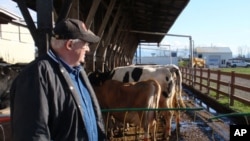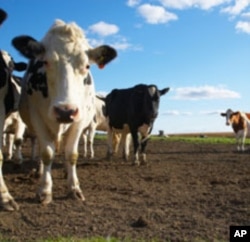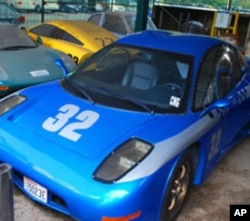Five years ago, dairy farmer Darryl Vander Haak flipped the switch on the first electric generator in Washington State powered by manure. The facility is officially known as a methane digester.
Manure from about 1,000 cows goes in one end and then, controlled decomposition yields methane gas at the other.
The raw material for the digester comes from livestock waste that might otherwise end up in a smelly manure lagoon on the farm. This so-called 'bio-gas' is burned like natural gas in a small electric power plant right on Vander Haak's farm. The dairyman sells his excess power to the local electric utility.
Methane digesters are increasing in number, especially in Europe. But there's an important difference between Europe and America: electricity in the U.S. is relatively cheap. Dairyman Vander Haak says his energy sales have not been profitable. "The Northwest has too much [cheap] hydropower to compete with," he points out, adding that he's been looking for alternative markets. "It would be easier to compete with the gas companies, I guess."
Cow power to horsepower
That's why Vander Haak was open-minded when the Vehicle Research Institute at Western Washington University, just down the road from his dairy, called with an offer to truck away some of his methane.
Institute director Eric Leonhardt says he's had his eye on the dairy herd as a source of transportation fuel for a long time. He calls it "cow power to horsepower."
Leonhardt says the challenge is to cost-effectively remove impurities from the manure-derived methane. "When the gas comes off the digester, it has not only methane in it - 60 percent -- it also has carbon dioxide -- 40 percent, roughly. And it has a trace of hydrogen sulfide," says Leonhardt. Those impurities rapidly corrode engine parts.
Powering vehicles with clean natural gas is not new. Nor is generating fuel from renewable sources. But cars and trucks that run on methane are still a novelty in the U.S.
However, since last year, biogas has gotten renewed attention from the Obama Administration as part of a larger push to promote domestic renewable energy.
The economics of methane-powered cars
The U.S. Department of Energy gave the Vehicle Research Institute a $500,000 grant to improve the biogas refining process and then demonstrate whether the fuel can be cost-competitive in cars. Leonhardt says a lot depends on the price of traditional fossil fuel.
It would have to climb higher to give consumers a financial incentive to switch. At present, the average price of gasoline in the United States is well below Leonhardt's barely-competitive threshold of about 75-cents per liter.
This spring, the Vehicle Research Institute plans to retrofit a donated shuttle bus to run on methane. It will take a few months of road testing to confirm Leonhardt's cost estimates. The researcher has already calculated that the cows from just two large dairies could fuel all the public buses in a medium-sized American city.













